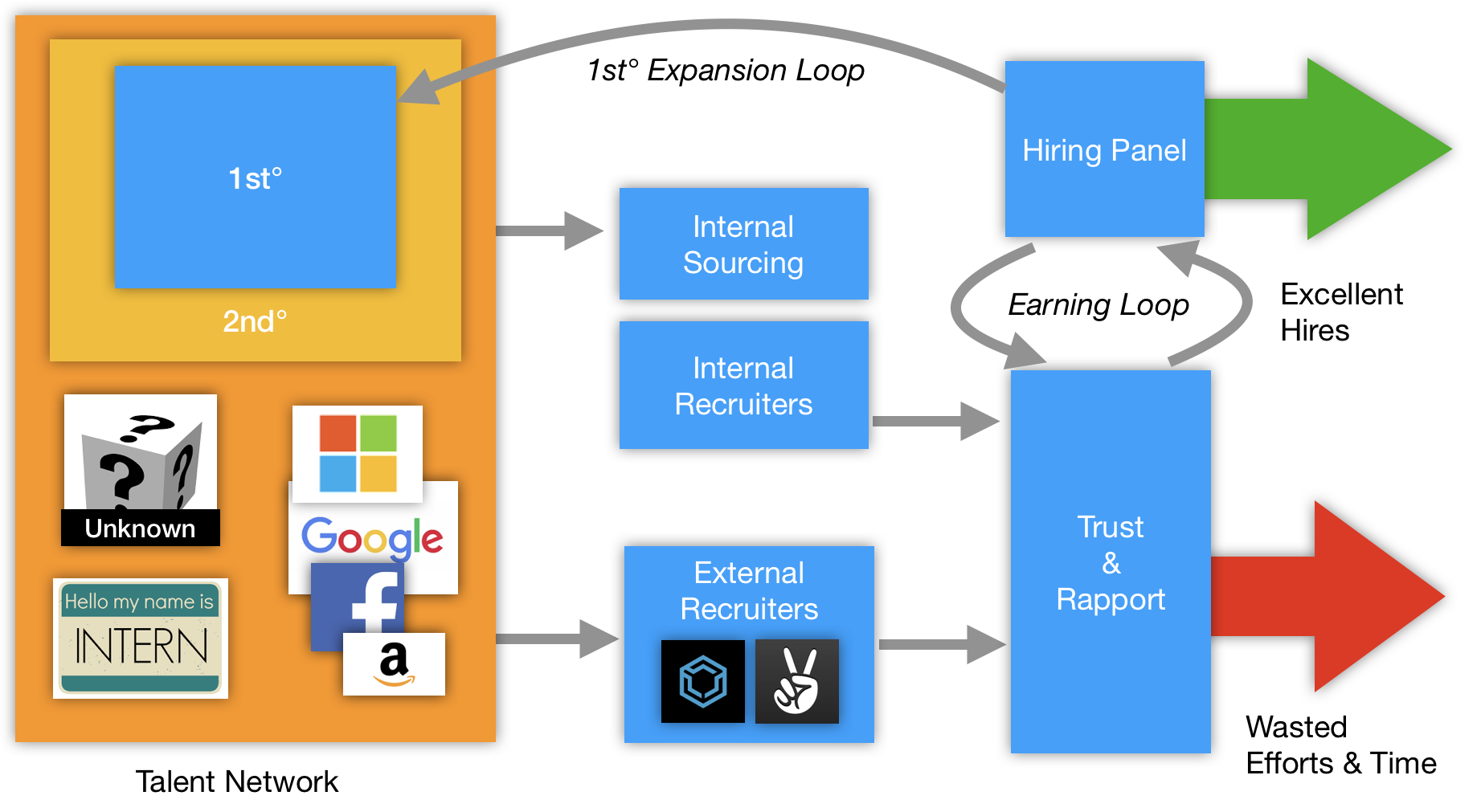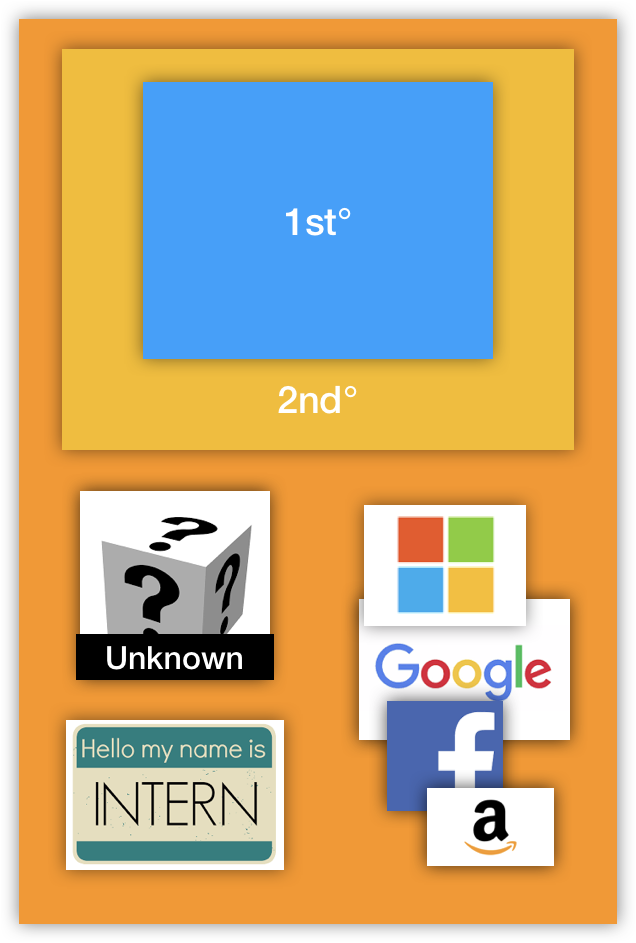
First up, let’s model a System for Hiring.
For each system, we’ll define its goals and a block & flow diagram to model out how it works.
It’s important to note we are setting a reasonable boundary for a system model. If we extend our system into a fractal of infinite resolution, we’ll never finish our modeling exercise.
Let’s keep things purposefully constrained and simplified.
The goals for the hiring system are:
- New hires with excellent potential to succeed in our downstream dream team systems: structuring, executing, and leveling up
- Minimize interview load on engineers so they can focus on executing
Seems obvious enough, but writing from experience, it’s clear that many hiring systems waste an exorbitant amount of time for both interviewees and interviewers. In addition, many systems do not leverage recruiters and sourcers effectively (key supporting roles we’ll unpack in a bit)

The Hiring System model includes:
- Inputs:
- Talent Pool (broken into: 1st, 2nd, and broader networks)
- Outputs:
- Hires with excellent potential as inputs into downstream systems
- Waste in the form of time spent on candidates who are not ultimately hired
- Feedback Loops:
- Earning Loop — A hiring panel that continues to build trust & rapport with candidates over time
- 1st° expansion loop — Each new hire expands the talent accessible to the system via the expansion of 1st and 2nd degree networks
Hiring
Hiring takes a significant amount of effort — especially during rapid growth.
It’s impossible for a single person to operate an entire hiring system. You’ll want to leverage a team of sourcers, recruiters, and a hiring panel to help execute this system.
We’ll explore these parts of the hiring system:
- Talent Network
- Sourcer
- Recruiters
- Trust & Rapport
- Hiring Panel
Talent Pool
To maximize talent ingress, you’ll want to mine multiple networks within the Talent Pool.

- The 1st degree is mined by having a sourcer build a list of all direct potential candidate connections from employees, investors, and advisors. These are candidates you can easily get a warm intro to and potentially start building Trust & Rapport with (more on R&T later).
- The 2nd degree is also fruitful for mining but requires working thru a friend of friend for an intro.
- The big tech companies (Google, Facebook, etc) are also a target for talent mining. There are countless brains locked in creative captivity with high compensation packages at these companies. However, that doesn’t keep them locked up forever. These candidates are indeed self-aware enough to know that can self-actualize faster at a startup that’s a perfect fit for their interests.
- The broader network of people from across the world can be accessed by using hiring services like Triple Byte, Toptal, and A-List (to name a few).
- Unaccredited — Do not filter out people without a college degree. There are many amazing autodidacts out there. You can use a platform like CodeSignal to screen for coding skillz for you.
- You’ll also want to be on the look out for young talent to develop via an internship program. Many of my top hires actually started as summer interns who later joined full-time when they finished school.
Sourcer
A sourcer mines the talent pool for leads.
A great sourcer will:
- Help craft your outreach email for max response rate.
- Use an email account that comes from your name. It’s important that the candidate is hearing about the opportunity in your voice and name (not a sourcer/recruiter).
- Use a tool like MixMax to automate candidate outreach when needed
- Hand tune emails for targeted candidates in the 1st/2nd degree network or for highly specialized roles.
Recruiter
Once a candidate warmly responds to a sourcer, they flow to a recruiter for follow up and potentially scheduling a deeper context gathering call.
If you’re a small startup, then you – the hiring manager – are most likely a recruiter and sourcer too. You’ll need tools to stay on top of scheduling and doing follow ups. I personally use Asana as a lightweight ATS for this, but there are many services out there. The AngelList ATS is particularly good and free.
Ideally you’ll have multiple irons in the fire sourcing & recruiting. You can contract with a number of hiring services simultaneously to greatly increase your candidate flow.
I’ll usually fire up engagements with 3 hiring services at once. The hiring service gets paid only when you actually make a hire they directly source. The hiring pipeline acceleration is well worth the fees they charge and should be considered essential partners for long term hiring needs.
Trust & Rapport
Next, vetted candidates flow into the most crucial part of the system — the trust & rapport building mechanism.
Put simply, it’s authentic relationship building. If you’re focused solely on finding a “gear”, then you will overlook that you’re dealing with people with their own internal limbic systems.
If you don’t take the time to really get to know and understand a candidate, why would they ever leave Google to join your nascent startup?.
If you suck at this, the best source to improve your skill is to read the seminal How to Win Friends and Influence People.
Don’t expect a candidate to be easily convinced in your Dream after a single meeting. You’ll need to continue to “water the garden” of your candidate connections by staying in touch and breaking bread together on multiple occasions.
Hiring Panel
Not everyone needs to be involved in hiring decisions.
Spreading the interviewing load across every engineer is a great way to fragment and destroy your team’s execution focus.
Instead a small panel can be assembled dedicated to hiring. This panel is tasked with keeping a certain standard (hiring bar) and process over time.
The hiring panel should consist of engineers who excel at the art and science of conducting an awesome interview. These engineers LOVE interviews. Not everyone likes doing interviews and as a consequence they will be terrible at it.
An engineer on a hiring panel with lots of headcount to fill will not have time for major feature work. Almost 80% of their time needs to be dedicated to the hiring system. This includes white glove “trust and rapport” building (over coffee, lunch, dinner, beer, kombucha, video games) in addition to a formal interviews.
Interview Process
The interview process should look for two types of fit: technical & cultural
Technical Fit
I’m a firm advocate of project based interviews to sort out technical fit. Writing code intended for a complier on a white board is not ideal.
My friend, and fellow biohacker, Ty Smith, explained the problem quite well on my podcast:
“In our industry, there is a stigma that someone who can’t remember the implementation for quicksort off the top of their head — and write it on a whiteboard — is not a good engineer. It’s just a fallacy. It excludes a lot of people with anxiety and from diverse backgrounds who can otherwise do great work in a comfortable & trusting environment.” ― Ty Smith, Biohacker, Tech Lead @Uber
The interview should seek to match the skills actually required for the job.
- Give them a real mini-project to work on
- How adept is the candiate at using all the resources (Github, Stack Overflow, Google) at their disposal?
- Do a bio-directional code review. How well do they take feedback? How detailed is the feedback they give in return?
In some cases, the whiteboard works great for drawing out architecture and modeling out concepts. Use the whiteboard in an interview as you actually use it in the work environ.
Cultural fit
Do your system design principles resonate with them?
You’ll only want to hire people who have potential to succeed in your dream team. A bad hire can seriously disrupt your system in the short-term. A perfect fit will cause the system to resonate.
You can get a sense of cultural fit by:
- Hanging out in nature
- Having a meal together
- Having them attend one of your team meetings
System Anti-patterns
It’s always insightful to highlight what the system should not do. We’ll end each system breakdown by covering some anti-patterns.
- Junior heavy — Hiring too many junior people in order to fill seats. A healthy ratio of senior:junior needs to exist.
- Lone-wolf — Trying to run the hiring system as solo operator. There is no way a single person can stay on top of workload required to continually operate this system. It needs consistent attention.
NEXT> We’ll explore a System for Structuring
GOTO: Table of Contents
© 2019 Adam Huda - Written in California & Montana with iA Writer